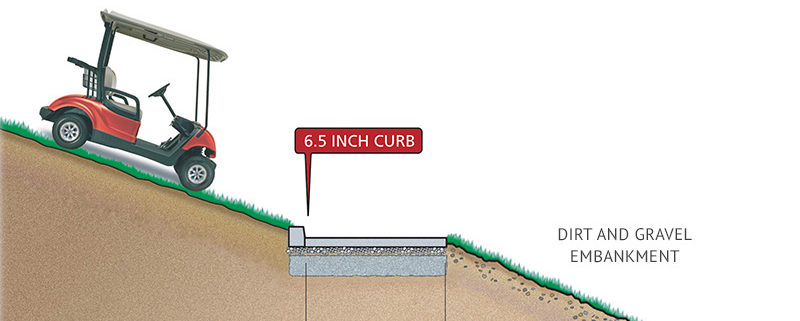A 69-year-old plaintiff was driving a golf cart while playing with her women’s golf group. While approaching the 8th green, she exited the fairway and drove off a curb that she could not see. The golf cart slammed onto the cart path and crossed over onto a steep embankment that led to a stand of trees. Unable to stop or steer, the woman instinctively jumped before the golf cart crashed into the trees. She survived, but sustained serious injuries to her hip, shoulder and knees, along with post traumatic stress.
Expert witness Michael S. Johnstone, AIA, was retained to investigate the golf cart accident. No mechanical issues were suspected. Weather, alcohol and medication were not factors. Witnesses testified by deposition that the golf course management had instructed community members to drive closer to the greens than usual to expedite play and help rehabilitate the turf. Signs that normally directed cart traffic to exit the fairway 50 yards sooner had been removed. The signs were immediately replaced after the accident. In addition, the manager expressed he always had concerns about the danger posed by the embankment on the other side of the path. After the accident, he promptly erected temporary stakes until a permanent guardrail was installed.
The investigation concluded there was a confluence of issues that caused the plaintiff’s accident… The plaintiff followed the explicit instructions of the golf course, but had no way to anticipate the peril that was created or that serious injury or death may result.
The site inspection revealed the plaintiff obeyed the golf course’s new policy, exiting the fairway at the last opportunity before reaching a bunker near the green. The route went over a large swale and down a steep slope of 19 degrees. From that angle, the grass rough concealed a 6-1/2” curb before dropping onto the cart path. To the plaintiff, however, it appeared there was a smooth transition like other areas along the fairway without any curb.
The investigation concluded there was a confluence of issues that caused the plaintiff’s accident. The intentional removal of directional signs changed the location where golf carts normally exited the fairway. By instructing players to drive closer to the green, some drivers reasonably exited in front of the bunker, sending them over the curb. The line of travel inadvertently concealed the sudden drop and caused a loss of control. Finally, the area directly across the cart path had another steep slope of 21 degrees, consisting of unmaintained dirt and gravel that afforded no traction. The latter was a dangerous condition previously known to the golf course and was exacerbated by temporarily routing golf carts over the curb directly into the area. The plaintiff followed the explicit instructions of the golf course, but had no way to anticipate the peril that was created, or that serious injury or death may result.
Routine maintenance, periodic rehabilitation or renovations often require the rerouting of golf cart paths. Unfortunately, accidents like this one may result if diligence toward safety is not observed. Tee boxes and greens may also vary from the intention of the golf course architect when short term modifications are in place. Ropes, warning signs, and other markings are recommended to inform players of temporary course changes. However, superintendents and groundskeeping staff may inadvertently create peril due to overlapping conditions. Many factors contribute to an accident, such as the experience and attention of the player. Yet, liability often hinges on whether a particular danger was foreseeable and preventable in the first place.



